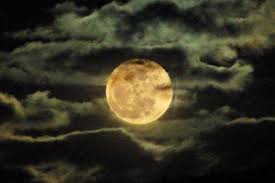The yellow moon has captured human fascination for centuries, inspiring folklore and superstitions around the world. It has been viewed as a powerful symbol with mystical and spiritual significance in many cultures. From being an omen of change to a representation of good fortune, yellow moon folklore and superstitions have shaped beliefs and traditions that continue to be relevant today. This article explores the intriguing folklore and superstitions surrounding the yellow moon, shedding light on its cultural impact and significance.
1. Introduction to Yellow Moon Folklore
Folklore associated with the yellow moon varies widely, depending on the cultural context. It is often seen as a symbol of mystery and transformation, with its appearance evoking a range of emotions and beliefs. Many legends and myths revolve around the yellow moon, making it a potent symbol in storytelling and religious practices.
2. Yellow Moon in Western Superstitions
In Western cultures, the yellow-moon-meaning has long been linked to superstitions. People believe that the yellow moon signifies significant changes, both good and bad. Some view it as a warning of upcoming storms or unstable weather, while others see it as an indicator of prosperity.
2.1 Yellow Moon and Harvest Festivals
The yellow moon is frequently associated with harvest festivals in the West. It is considered a time to celebrate abundance and give thanks for the crops. The Harvest Moon, which appears yellow, is seen as a sign of plenty and fulfillment.
2.2 The Yellow Moon as an Omen
Western superstitions often regard the yellow moon as an omen. A yellow moon is believed to foreshadow unexpected events or transformations, leading to caution and introspection among those who witness it.
3. Yellow Moon Folklore in Asian Cultures
In Asian cultures, the yellow moon holds deep spiritual and cultural significance. It is often connected to themes of unity, renewal, and reflection.
3.1 Chinese Mid-Autumn Festival
The yellow moon is celebrated during the Chinese Mid-Autumn Festival, symbolizing family reunion and harmony. People gather to appreciate the yellow moon’s beauty, exchange mooncakes, and honor their ancestors.
3.2 Japanese Moon Viewing Tradition
In Japan, the custom of “Tsukimi” involves gazing at the yellow moon to appreciate its beauty. The yellow moon is seen as a symbol of fleeting beauty and the transient nature of life, encouraging mindfulness and gratitude.
4. Indigenous Folklore and Beliefs
Indigenous communities around the world have their own interpretations of the yellow moon. For many, it is considered a guiding light and a symbol of transformation.
4.1 The Yellow Moon as a Guide
Indigenous tribes often view the yellow moon as a spiritual guide, helping individuals navigate personal challenges. The moon’s yellow hue is believed to offer protection and insight.
4.2 Rituals and Ceremonies
In some indigenous cultures, rituals and ceremonies are conducted under the yellow moon’s light. The yellow moon is thought to enhance spiritual awareness and connect individuals to their higher selves.
5. Yellow Moon in African Folklore
African folklore is rich with tales of the yellow moon and its role in communicating with the spirit world. It is often associated with ancestral spirits and divination.
5.1 Yellow Moon and Ancestral Spirits
The yellow moon is seen as a bridge between the living and the spirits. It is believed that ancestral spirits use the yellow moon to send messages and guidance to their descendants.
5.2 Storytelling and the Yellow Moon
The yellow moon plays a significant role in African storytelling. Folktales often describe the yellow moon as a wise elder, watching over communities and ensuring balance.
6. Yellow Moon Symbolism in Greek and Roman Mythology
In Greek and Roman mythology, the yellow moon is linked to the divine feminine and lunar deities. It is often seen as a symbol of purity, protection, and intuition.
6.1 Artemis and the Yellow Moon
The yellow moon is associated with Artemis, the Greek goddess of the hunt and the moon. Artemis is often depicted under a yellow moon, symbolizing her role as a guardian and protector of nature.
6.2 Selene and the Moon’s Phases
In Roman mythology, Selene, the goddess of the moon, is linked to the yellow moon. The yellow hue is seen as a representation of her nurturing and life-giving energy.
7. Yellow Moon in Astrology and Spirituality
Astrologically, the yellow moon is viewed as a time of heightened energy and emotional clarity. It is believed to influence intuition and spiritual insight.
7.1 The Yellow Moon’s Influence on Zodiac Signs
The yellow moon is thought to have a special impact on water signs such as Cancer, Scorpio, and Pisces. It is said to enhance emotional sensitivity and creativity.
7.2 Spiritual Practices Under the Yellow Moon
Spiritual practitioners often use the yellow moon’s energy for rituals and meditation. The yellow moon is believed to facilitate spiritual growth and self-discovery.
8. Yellow Moon in Modern Culture
In modern times, the yellow moon continues to inspire art, literature, and music. It is often used as a metaphor for introspection, change, and emotional expression.
8.1 Yellow Moon in Music and Literature
The yellow moon has been featured in numerous songs and books, symbolizing themes of love, loss, and hope. Its imagery is powerful and evocative, adding depth to artistic creations.
8.2 The Yellow Moon in Pop Culture
In pop culture, the yellow moon is frequently used as a backdrop for scenes of mystery or romance. It symbolizes the unknown and the ever-changing nature of life.
9. Conclusion
The yellow moon folklore and superstitions around the world demonstrate the profound impact this celestial phenomenon has on human culture and spirituality. From being a symbol of transformation and protection in Western and indigenous cultures to a representation of unity and renewal in Asian traditions, the yellow moon’s symbolism is as diverse as the societies that revere it. Home study Catholic-based homeschooling programs often incorporate these rich cultural narratives, as its presence in mythology, folklore, and modern culture continues to captivate and inspire, bridging the gap between the natural world and the human experience.
